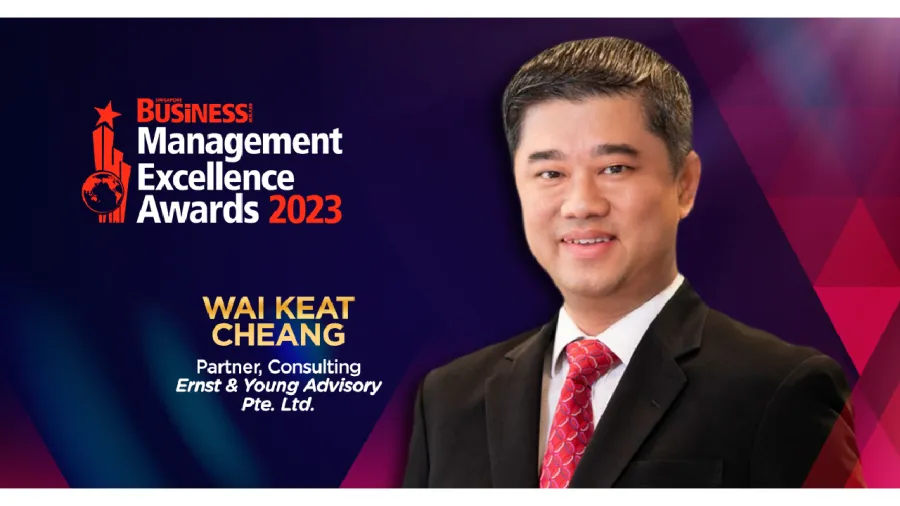
EY’s Wai Keat Cheang on the impact of emerging technologies, M&A integration, and diversity on management practices
As one of the judges at the SBR Management Excellence Awards, he shares his insights on navigating the changing landscape of management in an era of technological advancements and inclusivity.
Effective management practices serve as the bedrock of organisational success, ensuring efficiency, adaptability, and sustained growth. In an era marked by rapid technological advancements and shifting workplace dynamics, the role of management has evolved significantly.
Wai Keat Cheang, Partner in Consulting at Ernst & Young Advisory Pte. Ltd., brings a wealth of experience to the table, with a focus on consulting, digital transformation, and technology. His extensive Asia Pacific consulting experience encompasses a diverse array of industries, including life sciences, health care, consumer goods, agribusiness, transportation, and real estate. Holding a bachelor's degree in Computer Science with Merit from the National University of Singapore, Wai Keat is not only well-versed in technology but also certified in production and inventory management (APICS CPIM).
As one of the judges in the SBR Management Excellence Awards 2023, Singapore Business Review spoke with Wai Keat Cheang as he delved into the transformative impact of emerging technologies on management practices. From artificial intelligence (AI) and machine learning (ML) to the Internet of Things (IoT) and cloud computing, he provides strategic insights on how organisations can leverage these technologies to enhance operational efficiency and remain competitive.
The discussion also goes beyond technology, touching on the intricacies of post-merger integration, as well as diversity and inclusion’s positive influences on an organisation's ability to manage risks effectively and drive financial success.
What emerging technologies or trends do you believe will have the most significant impact on management practices in the near future, and how should organisations adapt?
Emerging technologies such as artificial intelligence (AI) and machine learning (ML), the internet of things (IoT), cloud computing, data analytics and business intelligence tools, as well as remote work and collaboration tools, will have the most significant impact on management practices.
Some ways that organisations can leverage these five technologies to improve operational efficiency and remain competitive include:
AI and ML: AI and ML technologies are already transforming various industries and their impact is expected to grow. The EY CEO Outlook Pulse Q3 2023 found that 66% of Singapore respondents view AI as a driving force when it comes to business efficiency. Organisations can use AI and ML to automate manual and repetitive tasks, develop intelligent products and services, and create a differentiated customer experience.
IoT: IoT devices are becoming increasingly prevalent, enabling organisations to collect vast amounts of data across a multitude of sources. By investing in strategies to effectively manage and analyse IoT-generated data, organisations can gain real-time access to important information for quick decision-making, optimise operations and drive innovation.
Cloud computing: Cloud computing offers scalability, flexibility and cost-efficiency for organisations. Those that have adopted a cloud-enabled IT operating model have been less prone to business disruption as they continue to be able to meet demand without the need to scale down their IT operating costs when margins are tight or without the limitations of on-premises data centres. In order to embrace cloud technologies effectively, organisations should start by understanding their asset landscape, which includes the level of customisation required and complexity anticipated when migrating, having clarity on potential security and governance issues, as well as deploying training and development initiatives to embed the new ways of working.
Data analytics and business intelligence: With the abundance of data available, organisations need to harness the power of data analytics and business intelligence tools to gain actionable insights. According to the 2022 biennial EY Tech Horizon Study, data analytics was identified by senior executives across Asia-Pacific as their top investment priority in the next two years, up from 31% in 2020. Data expertise is not just limited to the IT department, but also infused across business groups, internal operations and customer relationships. By leveraging data, organisations can create intelligence and insights to allow them to understand their consumers better, analyse the latest market trends, and improve and innovate new products and services which will be beneficial for consumer retention and attraction.
Remote work and collaboration tools: The pandemic accelerated the adoption of remote work practices. The EY Work Reimagined Survey 2023 reflects that flexibility is now a baseline expectation for Singapore knowledge workers (those whose work is traditionally based primarily on using analysis or subject expertise in a professional office setting), with only 13% willing to work fully in the office. Organisations should support remote work practices by providing employees with the necessary tools and technologies for effective collaboration whilst ensuring data security.
Post-merger integration can be a complex process. Can you provide insights into key challenges organisations face during this phase and strategies to ensure a smooth integration that doesn't disrupt ongoing operations?
Post-merger integration is a complex and critical phase in the M&A process due to the level of interdependencies throughout the entire organisation. The success of a post-merger integration warrants a unique set of resources and skills that may not be built into the core operating model of an organisation. However, by appointing an experienced M&A leader, assembling a core team and establishing a clear and structured timeline, organisations can ensure a smoother integration with minimal operational disruptions.
A common challenge that companies face is employee integration. M&A impacts a diverse set of stakeholders, with employees at the core. Combining different company cultures can lead to resistance, and impact employee morale and talent retention. Hence, organisations need to focus on change management and communication to rally internal support and pace the changes that occur throughout integration. The core M&A team should provide clear and regular information about the deal intent and business goals, as well as matters that affect employees like reporting structures, roles and responsibilities, and career development opportunities. This can assuage job security concerns. In addition, the change management strategy should include training and support to help employees adapt to new structures, processes and systems.
Another oft-cited bugbear is the integration of IT systems and technology platforms, potentially resulting in data migration issues, downtime and service disruptions. For a seamless IT integration, organisations should put together a dedicated team to conduct due diligence, take stock of existing IT assets, plan for system compatibility challenges, and prepare for eventual data migration. It is important to buffer sufficient time for migration so that business operations are not severely affected for long periods during this process.
Another consideration for companies is customer disruption. If not managed carefully, changes in the company's operations, branding or service can disrupt existing customer relationships. Thus, organisations should consider customers in their decision-making. As much as possible, keep the M&A process separate from day-to-day business operations. This minimises service gaps with customers. Customers too are concerned about how the merger and changes will affect them. Hence, organisations should maintain regular communication with their customers throughout the process.
Lastly, an M&A comes with its own set of legal guidelines and regulatory considerations. There are large amounts of sensitive and non-sensitive data that are shared between organisations. The core M&A team will need to work with their legal teams for compliance with laws and regulations and identify any potential risks and how to address them. There should also be confidentiality expectations and mechanisms for safe data-sharing.
In essence, M&As require comprehensive planning. Organisations should develop a detailed roadmap that outlines the steps, responsibilities and timelines. It is important to monitor progress by regularly reviewing the integration process and be prepared for adjustments when unexpected challenges or unforeseen setbacks arise.
Diversity and inclusion have become central to many organisations’ values. From a management perspective, how can a commitment to diversity and inclusion positively impact an organisation's ability to manage risks effectively and drive financial success?
The EY Work Reimagined Survey 2023 highlights that indicators of leadership success include having a diverse workforce. Indeed, commitment to diversity and inclusiveness is not just about social responsibility; it can be a powerful driver of financial success and risk mitigation. Diverse perspectives, combined with an inclusive culture and equitable opportunities, drive better decision-making, stimulate innovation, increase organisational agility and strengthen resilience to disruption. Inclusive organisations maximise the power of all differences and realise the full potential of all their employees. This minimises blind spots and encourages truly innovative thinking, which is critical to helping organisations deliver long-term value in today’s global marketplace.
As a judge at the SBR Management Excellence Awards, could you shed light on the specific criteria or attributes you look for when evaluating organisations?
The SBR Management Excellence Awards recognises organisations for their exceptional leadership in the market, innovation to address business/industry challenges and people engagement initiatives to increase teaming, motivation and contribution.
There should be clear and measurable outcomes that are sustainable for the long term. Innovations should be unique and realistic – more importantly, they should solve a critical problem or challenge resulting in a positive ROI over a reasonable time frame. Lastly, all people initiatives should enhance employee engagement and career experience.



![SBR 5 Lorem Ipsum News 2 [8 May]](https://cmg-qa.s3.ap-southeast-1.amazonaws.com/s3fs-public/styles/exclusive_featured_article/public/2025-05/a_hand_pointing_to_a_futuristic_technology_5b87c9d0e3_3.png.webp?itok=M3Hf-9XR)
![SBR 4 Lorem Ipsum [8 May Top Stories]](https://cmg-qa.s3.ap-southeast-1.amazonaws.com/s3fs-public/styles/exclusive_featured_article/public/2025-05/a_hand_pointing_to_a_futuristic_technology_5b87c9d0e3_2.png.webp?itok=2m5Wl0MX)


![Exclusive three SBR 12 Lorem Ipsum [8 May]](https://cmg-qa.s3.ap-southeast-1.amazonaws.com/s3fs-public/styles/exclusive_featured_article/public/2025-05/a_hand_pointing_to_a_futuristic_technology_5b87c9d0e3_11.png.webp?itok=8kn_UIfA)
![SBR 3 Lorem Ipsum [ Exclusive 2]](https://cmg-qa.s3.ap-southeast-1.amazonaws.com/s3fs-public/styles/exclusive_featured_article/public/2025-05/a_hand_pointing_to_a_futuristic_technology_5b87c9d0e3_1.png.webp?itok=YCyjLegJ)
![SBR 2 Lorem Ipsum [8 May]](https://cmg-qa.s3.ap-southeast-1.amazonaws.com/s3fs-public/styles/exclusive_featured_article/public/2025-05/a_hand_pointing_to_a_futuristic_technology_5b87c9d0e3_0.png.webp?itok=_cKD-29o)

![Video [Event News]](https://cmg-qa.s3.ap-southeast-1.amazonaws.com/s3fs-public/styles/event_news_featured_article/public/2025-05/screenshot-2025-05-08-at-4.58.53-pm_0.png.webp?itok=Kud35sMs)
![Event News SBR 9 Lorem Ipsum [8 may]](https://cmg-qa.s3.ap-southeast-1.amazonaws.com/s3fs-public/styles/event_news_thumbnail/public/2025-05/a_hand_pointing_to_a_futuristic_technology_5b87c9d0e3_8.png.webp?itok=DTh_dbYp)
![Event News SBR 9 Lorem Ipsum [8 May]](https://cmg-qa.s3.ap-southeast-1.amazonaws.com/s3fs-public/styles/event_news_thumbnail/public/2025-05/a_hand_pointing_to_a_futuristic_technology_5b87c9d0e3_7.png.webp?itok=vzDAzb6V)
![Event News SBR 8 Lorem Ipsum [8 May]](https://cmg-qa.s3.ap-southeast-1.amazonaws.com/s3fs-public/styles/event_news_thumbnail/public/2025-05/a_hand_pointing_to_a_futuristic_technology_5b87c9d0e3_6.png.webp?itok=jvHFc4P6)
![Video [Event News]](https://cmg-qa.s3.ap-southeast-1.amazonaws.com/s3fs-public/styles/video_thumbnail/public/2025-05/screenshot-2025-05-08-at-4.58.53-pm_0.png.webp?itok=yZnI0YBb)
![Video 1 SBR [8 May]](https://cmg-qa.s3.ap-southeast-1.amazonaws.com/s3fs-public/styles/video_thumbnail/public/2025-05/screenshot-2025-05-08-at-4.58.53-pm.png.webp?itok=9AAeRz_k)

 Advertise
Advertise

